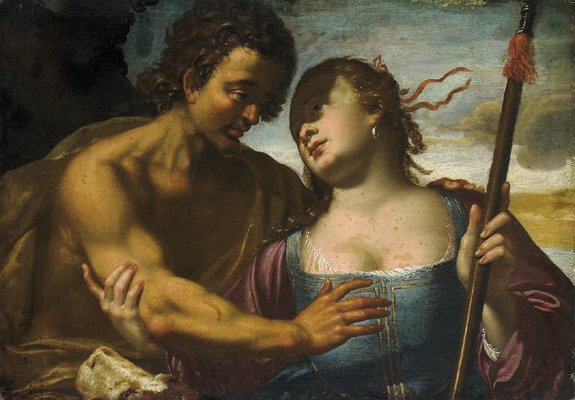By Mary Sharratt (Guest Contributor)
The origins of Saint Valentine’s Day lie shrouded in obscurity. Saint Valentine himself, a third century Roman martyr, seems to have nothing to do with the romantic traditions that became associated with his feast.
Dr. Douce, in his Illustrations of Shakespeare, cited in The Book of Days, writes:
It was the practice in ancient Rome, during a great part of the month of February, to celebrate the Lupercalia, which were feasts in honour of Pan and Juno. whence the latter deity was named Februata, Februalis, and Februlla. On this occasion, amidst a variety of ceremonies, the names of young women were put into a box, from which they were drawn by the men as chance directed. The pastors of the early Christian church, who, by every possible means, endeavoured to eradicate the vestiges of pagan superstitions, and chiefly by some commutations of their forms, substituted, in the present instance, the names of particular saints instead of those of the women: and as the festival of the Lupercalia had commenced about the middle of February, they appear to have chosen St. Valentine’s Day for celebrating the new feast, because it occurred nearly at the same time.
The first mention of Valentine’s Day traditions in England originate from the 14th century writers Geoffrey Chaucer and John Gower who both allude to the folk belief that birds choose their mates on the feast of Saint Valentine, their patron.
In Britain, the mating flights of crows, rooks, and ravens can generally be observed by February 14. Here in Lancashire, I notice more and more birdsong each day as February advances and the birds repair their nests, preparing for a new cycle of birth and life.
Around 1440, John Lydgate’s poem in honour of Queen Katherine, widow of Henry V, is the first to mention romantic traditions among humans associated with this date:
To look and search Cupid’s calendar,
And choose their choice, the great affection.
People of both sexes sent tokens of admiration. You could either send a token to the romantic interest of your choice, or draw lots as to who would receive your Valentine. In 1470s Norfolk, the Paston family seems to have preferred drawing lots rather than sending tokens to a chosen person.
Actual Valentines could be quite costly. In 1523, Sir Henry Willoughby, gentleman of Warwickshire, paid 2S, 3d for his. Unfortunately no description of this costly item remains for us today.
After the Reformation, the feast of Saint Valentine was abolished, and yet the amorous traditions flourished.
By 1641, the system of casting lots for Valentines was so well known in Edinburgh that a wag waggishly proposed their new Lord Chancellor be chosen by the same method.
A Dutch visitor to London in 1663 observed:
it is customary, alike for married and unmarried people, that the first person one meets in the morning, that is, if one if a man, the first woman or girl, becomes one’s Valentine. He asks her name which he takes down and carries on a long strip of paper in his hat band, and in the same way the woman or girl wears his name on her bodice; but it is the practice that they meet on the evening before and choose each other for their Valentine, and, come Easter, they send each other gloves, silk stockings, or sometimes a miniature portrait, which the ladies wear to foster the friendship.
In his diaries of the same decade, Samuel Pepys reveals how he would call by a colleague’s house early in the day in order to make the man’s daughter his Valentine. Pepys would also arrange for a young man to call to pay the same homage to Mrs. Pepys and bring her presents, which Pepys then paid for. One year when Pepys was short of cash, alas, no young man with presents appeared and Mrs. Pepys was quite irate. Eventually they settled on a yearly ritual, whereby Pepys’s cousin paid a visit to honour Mrs. Pepys and bring her presents which Pepys knew she desired.
Sources:
The Book of Days
Ronald Hutton, The Stations of the Sun: A History of the Ritual Year in Britain
 Mary Sharratt’s explorations into the hidden histories of Renaissance women compelled her to write her most recent work, THE DARK LADY’S MASK (Houghton Mifflin Harcourt 2016), based on the dramatic life of the ground-breaking poet, Aemilia Bassano Lanier.
Mary Sharratt’s explorations into the hidden histories of Renaissance women compelled her to write her most recent work, THE DARK LADY’S MASK (Houghton Mifflin Harcourt 2016), based on the dramatic life of the ground-breaking poet, Aemilia Bassano Lanier.
Born in Minnesota, Mary now lives with her Belgian husband in the Pendle region of Lancashire, England, the setting for her acclaimed novel, DAUGHTERS OF THE WITCHING HILL, which recasts the Pendle Witches of 1612 in their historical context as cunning folk and healers.

